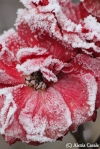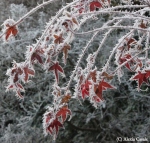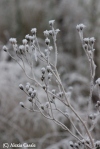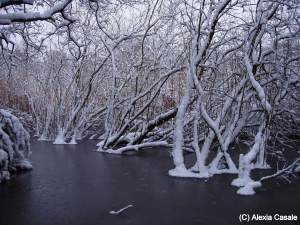Part of writing ‘what you know’ is writing ‘where you know’.
You can accomplish a huge amount via distance research, but there is no substitute for visiting the place you want to write about. If a place is too far (out of your wallet), then try to visit somewhere similar. You might miss small local nuances but there are quite a lot of similarities between one beech wood and another, or between one heathland marsh and another. Research may be enough to fill in the gaps, provided you have a sense of what facts you need to check.
On fieldtrips, I don’t make many notes about the places I go. Sometimes I draw little (bad) maps. But mostly I take photos. For me, photos are the best form of notes about places, not just in terms of what I saw when I was there but also in terms of what I felt and smelt and heard. With a little thought and practice, it’s quite easy to figure out how to take photos that will trigger your other senses. Just don’t get caught up in taking pretty holiday snaps. Fieldtrip photos are there as a record. Their purpose is to jog your memory. Pretty pictures are great but they’re a separate thing. Make sure you take both when you’re on a fieldtrip. Also, remember to take both close-up detail and long-shots so you have a sense of the lay out and where things are in relation to each other.
The Bone Dragon is set on the Cambridgeshire fens. Roughly. Give or take. Thereabouts. It’s not set in a particular village or town: the place isn’t even given a name. But it is somewhere that could exist. And it’s clearly roughly where it would be if it did.
I lived in Cambridge for more than four years, studying and working, so I know the town very well. Of course Cambridge isn’t the fens, but it’s geographically very close and it has the Backs and a canal stretch and lots of things I have very vivid memories of that are just the same as out in the fens.
Now, I have never spent much time in the fens themselves, but I have visited various parts of them so I know which aspects of Cambridge are the same as out in the wilds. Also, spent a lot of my teens imposing upon my lovely long-suffering auntie and uncle who live in the bit of Essex right by Cambridge (so on the edge of fen country). The areas are relatively similar, especially when you get out into the wetter, wilder places – which I did, since I’ve always loved walking… and exploring every possible path. (What a lovely sewage works I discovered on one such foray!)
When I was writing The Bone Dragon and needed some fresh inspiration, but didn’t have a lot of time, there were two forests nearby with marshy heathland that I could squelch about in. So between my memories of Cambridge, my memories of the Essex wilds near the fens, trips to the fens themselves, and heathland squelchings, I felt I could conjure the ‘where’ of The Bone Dragon into being in my study any time I needed. To what extent I succeeded, I invite you to see for yourself by reading my book (subliminal message: buy my book! buy my book!).
So when I say ‘write where you know’, I don’t mean you can only write about the place you live (or places you’ve lived), but think carefully about whether you would write better if you set your story somewhere you know or somewhere like a place you know. If you’ve no real life experience of a similar place, it will be very hard to build a realistic sense just from research. You probably won’t be able to say very much about the place or you’ll risk straining the reader’s credulity if it’s somewhere they know or like somewhere they know. The tricky thing is cities: many are far more different than first thought would suggest.
If the ‘where’ of your story doesn’t matter very much, it’s easy to write believably so long as you don’t go into much detail. But it’s a pity to lose the depth that setting can bring to a story. If you’ve got believable characters walking around in a grey, blurry world, readers aren’t going to engage as much. And it entirely rules out the possibility of establishing a setting that is almost a character in its own right – something that’s important to me as a writer.
So when you’re starting out with a new idea have a think. Where do you know? Chances are there are a lot of wheres you could write about. Why not pick one of them, or somewhere similar, rather a place/type of place you have no lived experience of at all?
There’s always the temptation to just invent your where, as I did with The Bone Dragon. And that’s fine, but your where has to be plausible for its rough, give-or-take, hereabouts setting. The where of The Bone Dragon may exist only in my head, but if I put a lot of cacti in it I’d have a problem even so. As it is, I couldn’t take you to the specific places Evie and the Dragon visit at night, but I could take you to lots of places that would do just as well. And knowing that gives me a different sense, when I’m in the World of the Book, of actually being in a real place: a place I can step into (if only in my head) and look around for inspiration. It’s a place I can explore whenever I want to because in my head there is a full three-dimensional fenland village that supplies all the sensory input I could possibly need without my having to build it in afresh every time I sit down at my computer.
My new book is set in Cambridge, but down the line there will be books set in a beech wood and books set in a version of rural Italy and books set in London… I have a lot of wheres to draw on. If you think about it, you’ll probably find that you do too.



















